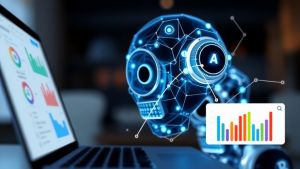Discover the Future of Business Analysis in 2025 and learn how AI, automation, and data-driven strategies are transforming Business Analysts into strategic innovators. Explore skills, tools, and trends shaping the AI era.

-
Introduction: The Future of Business Analysis
-
How AI & Automation Transform Business Analysts
-
Why Business Analysis Is Essential for Digital Transformation
-
Data Visualization in the Future of Business Analysis
-
Skills Needed for the Future of Business Analysis (2025+)
-
Traditional vs Data-Driven Business Analysis
-
Business Analysts in Agile Environments
-
Top Business Analysis Tools for 2025
-
3-Month Skill Roadmap for Aspiring BAs
-
Business Analyst vs Data Analyst
-
Conclusion
The Future of Business Analysis in the AI Era (2025 & Beyond)
(Focus Keyword used at beginning)
AI, automation, and data-driven intelligence are reshaping the Future of Business Analysis at a rapid pace. Business Analysts are no longer just requirement gatherers; they’re becoming strategic architects in an AI-powered workplace.
The modern business landscape is shifting faster than ever before — driven by AI, automation, and data-centric decision-making. In this era of digital transformation, Business Analysts (BAs) have evolved from requirement-gatherers to strategic change agents who bridge the gap between technology, business strategy, and innovation.
As companies navigate the challenges of AI adoption, agile development, and competitive global markets, the role of the Business Analyst is no longer optional — it’s essential. This article explores how AI and automation are transforming business analysis, the skills analysts need to stay relevant, and the tools shaping the profession’s future.
1. How AI and Automation Are Transforming Business Analysts’ Responsibilities
AI and automation have become integral to business operations, from automating routine workflows to predicting customer behaviors. For Business Analysts, this means:
- Shift from documentation to strategy:
AI handles repetitive data entry and requirement tracing, freeing analysts to focus on interpreting insights and aligning technology with business value. - Smarter decision support:
Analysts use AI-driven tools like ChatGPT, Tableau AI, and Power BI Copilot to interpret patterns from massive data sets in minutes — something that once took days of manual analysis. - Predictive and prescriptive analytics:
Instead of reporting what happened, BAs now use machine learning to forecast what will happen and recommend optimal business strategies. - Process automation mapping:
Analysts identify areas where RPA (Robotic Process Automation) or AI bots can streamline operations — a key contribution in digital transformation projects.
AI doesn’t replace the Business Analyst — it elevates them from a technical interpreter to a strategic innovator.
2. The Importance of Business Analysis in Digital Transformation

Digital transformation is not just about adopting technology — it’s about changing how organizations think, operate, and deliver value. Here’s where the Business Analyst becomes indispensable.
Key Contributions:
- Aligning business goals with digital strategy:
Analysts ensure every digital investment supports measurable business outcomes. - Translating data into business language:
They interpret analytics into actionable insights for non-technical stakeholders. - Change management:
Digital transformation often faces resistance; BAs facilitate smooth adoption through communication, training, and workflow redesign. - End-to-end visibility:
From process analysis to post-implementation review, BAs track whether digital initiatives deliver the intended ROI.
Without strong business analysis, digital transformation risks becoming a collection of disconnected tech upgrades — not true innovation.
3. How Business Analysts Can Leverage Data Visualization Tools for Better Reporting
In today’s data-heavy world, visual storytelling is the BA’s secret weapon. Tools like Power BI, Tableau, Qlik Sense, and Looker empower analysts to present data in intuitive, actionable ways.
Best Practices for Data Visualization:
- Start with the audience: Know who you’re speaking to — executives need trends; developers need technical metrics.
- Use dynamic dashboards: Create interactive visuals that let users drill down into specific metrics.
- Highlight KPIs, not clutter: Focus on insights that directly impact business goals.
- Automate data refreshes: Integrate real-time analytics using APIs or cloud connectors.
- Add AI insights: Tools like Tableau GPT can automatically generate explanations for anomalies and forecasts.
Data visualization transforms Business Analysts from reporters of information into narrators of intelligence.
4. The Future of Business Analysis — Skills for the AI Era
As automation takes over repetitive tasks, Business Analysts must cultivate hybrid skills — a mix of analytical expertise, technical proficiency, and strategic acumen.
Top Future-Ready Skills:
- Data literacy: Understanding statistics, SQL, and data modeling.
- AI awareness: Knowing how AI models function and how to apply them ethically.
- Automation design: Mapping processes for RPA and workflow automation.
- Critical thinking: Turning raw data into meaningful strategy.
- Communication & storytelling: Articulating insights for diverse audiences.
- Agile methodology: Working in sprint-based environments to adapt quickly.
- Tool mastery: Using analytics platforms (Power BI, Jira, Miro, Lucidchart, etc.) effectively.
In short — the Business Analyst of 2025 must be part analyst, part strategist, and part technologist.
5. Traditional Business Analysis vs. Data-Driven Analysis (2025)

| Aspect | Traditional Business Analysis | Data-Driven Business Analysis (2025) |
| Focus | Process optimization | Predictive and outcome-focused insights |
| Data Use | Historical, descriptive | Real-time, predictive, AI-assisted |
| Tools | Excel, Visio, static reports | Power BI, Tableau, SQL, Python |
| Decision Making | Based on experience | Based on data evidence |
| Role of BA | Documentation & liaison | Strategy, analytics, and innovation |
| Speed | Linear, manual | Agile, automated, and adaptive |
The 2025 Business Analyst doesn’t just describe what happened — they anticipate what’s next.
6. The Role of a Business Analyst in Agile Project Management
In agile teams, the BA acts as a collaborative bridge between stakeholders and developers, ensuring clarity, speed, and alignment.
Key Agile Responsibilities:
- Breaking down user stories and defining acceptance criteria.
- Maintaining a backlog that aligns with sprint goals.
- Facilitating communication between product owners and technical teams.
- Using tools like Jira, Confluence, and Miro for visual sprint planning.
- Continuously gathering feedback to improve processes.
In essence, BAs bring structure to agility — ensuring that speed doesn’t compromise quality or business value.
7. Top 10 Business Analysis Tools for 2025 (With Use Cases)
- Jira – For agile backlog management and sprint tracking.
- Confluence – For documentation and stakeholder collaboration.
- Power BI – For advanced data analytics and visualization.
- Tableau GPT – For AI-powered dashboards and predictions.
- Lucidchart / Miro – For process mapping and brainstorming.
- ClickUp / Monday.com – For cross-functional project tracking.
- ChatGPT / Claude.ai – For automating documentation and brainstorming.
- SQL / Python – For querying and analyzing large data sets.
- Balsamiq / Figma – For UI/UX wireframing and prototyping.
- Google Looker Studio – For cloud-based business intelligence.
Mastering these tools gives BAs a competitive edge — turning analysis into insightful storytelling.
8. How Business Analysts Add Value to Strategic Decision-Making
In modern enterprises, BAs sit at the intersection of data, strategy, and execution.
They add value by:
- Identifying opportunities that improve profitability and efficiency.
- Bridging communication between tech and business teams.
- Ensuring alignment between goals, KPIs, and operational processes.
- Recommending data-backed decisions instead of assumptions.
- Enhancing agility through continuous improvement cycles.
On LinkedIn or executive boards, Business Analysts are increasingly recognized as decision enablers — not just project contributors.
9. A 3-Month Professional Development Roadmap for Aspiring Business Analysts
| Month | Focus Area | Key Actions |
| Month 1: Fundamentals | Learn BA basics — requirements gathering, stakeholder management, business process modeling. | Take a foundation course (CBAP/PMI-PBA). Practice writing user stories. |
| Month 2: Tools & Technology | Develop technical skills. | Learn Power BI, SQL, Jira, and Lucidchart. Create mock dashboards. |
| Month 3: Advanced Practice | Work on real or simulated projects. | Conduct case studies, build documentation, and share findings on LinkedIn. Seek feedback from mentors. |
By the end of 90 days, you’ll have the knowledge, portfolio, and confidence to start your BA career or move to a higher-level role.
10. Business Analyst vs. Data Analyst — What’s the Difference?

| Aspect | Business Analyst | Data Analyst |
| Primary Focus | Business problems, process improvement | Data collection, cleaning, and analysis |
| Objective | Align business strategy with IT solutions | Provide data insights for decision-making |
| Skills | Communication, process modeling, agile, stakeholder management | SQL, Python, statistics, machine learning |
| Tools | Jira, Power BI, Lucidchart, Miro | Python, R, Tableau, Excel |
| Output | Business requirements, process improvements, reports | Data models, dashboards, predictive analytics |
Both roles are complementary. The Business Analyst interprets what should be done, while the Data Analyst explains why and how through data.
Conclusion:
Business Analysts — The Strategic Architects of the AI Era
As we move deeper into 2025, the Business Analyst’s role is transforming into that of a strategic navigator in the AI-driven enterprise. With automation handling repetitive analysis, BAs are free to focus on creativity, strategy, and impact.
They are the connective tissue between humans and machines — ensuring technology serves business goals, not the other way around. The future belongs to analysts who blend critical thinking, data fluency, and emotional intelligence to guide organizations through change.
In an AI-first world, the Business Analyst remains human-first — and that’s their ultimate superpower.
SEO Keywords: Business Analyst, AI in Business Analysis, Digital Transformation, Data Visualization, Agile Project Management, Business Analysis Tools, Business Analyst vs Data Analyst, Future of Work 2025


